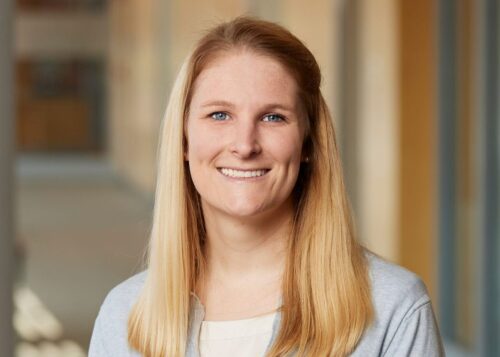Finding Joy in Food: How Cooking With Others Can Bolster Recovery
September 14, 2023
By Katie Dillon

David Salafia, Boston Medical Center
BMC's Cooking for Recovery Program addresses nutrition, body image issues, and food access for people with addiction while providing space to make a home-cooked meal.
Preparing your own meal is not only linked to more nutrient-rich food, but there are also psychological benefits as well. For people in recovery from substance use disorder (SUD), cooking can provide structure, confidence, and — in the case of cooking classes or group cooking — a sense of belonging.
The Teaching Kitchen at Boston Medical Center launched its Cooking for Recovery program as a way to bring these benefits of preparing your own meals to people with substance use disorder. Its website says the program aims to enhance participants’ “self-care toolbox” through nutrition education, addressing body image concerns, and teaching life skills, incorporating food insecurity and congregate/shelter living into its education. The nutrition education piece is crucial, as both drugs and alcohol can impact how the body metabolizes and processes food, and malnutrition is common among people with SUD. Nutrition plays a key role in the treatment and recovery process for individuals with substance use disorder. Both drugs and alcohol impact how the body metabolizes food and an individual’s ability to absorb nutrients. Malnutrition, common in individuals with SUD, can increase a physical dependence on substances.
Cooking for Recovery launched in 2018 through the support of the Spencer Streetman Memorial Fund, established by Kim and Richard Streetman in honor of their son Spencer, a mainstay of Boston’s culinary scene before his death at age 33. The program also partners with EMO Health, a nonprofit that works to improve drug safety, education, and treatment options for SUD.
Currently the Cooking for Recovery Program partners with two treatment clinics at BMC’s Grayken Center for Addiction: the Stimulant Treatment and Recovery Team (START) clinic, which works with patients who use stimulants, and CATALYST, which works with teens and young adults who use drugs. It also runs groups in the community with the help of EMO Health.
To learn more about Cooking for Recovery and cooking’s relationship to recovery, HealthCity spoke with Gabrielle Simons, MS, RD, LDN, manager of Boston Medical Center’s Teaching Kitchen; Kristin Parent, LMHC, START Clinic program manager; and Ashley Dortch, LICSW, LADC, a social worker with CATALYST.
HealthCity: How and why did the START and CATALYST clinics get involved in the Teaching Kitchen’s Cooking for Recovery program?
Kristin Parent, LMHC: A lot of times when people use stimulants, they lose a lot of weight just due to stimulants suppressing the appetite — and then people forget to eat, then want to gain back healthy weight back. We want to show them what that looks like and about eating nutritious foods. We at START were so excited to partner with the Teaching Kitchen.
Ashley Dortch, LICSW, LADC I: We at CATALYST were encountering a lot of young people who are underweight and really struggling with weight gain. Part of that is at their age; they might not prioritize food and nutrition and may not have the skills and opportunity to learn how to cook. In some cases, though, their substance use did affect either their appetite or the organization skills to get meals going for themselves. So, we figured we could target all of that in this partnership with Cooking for Recovery.
HC: How do you approach nutrition and food access, especially for patients with unstable housing or other social determinants of health that intersect with substance use disorder or using drugs?
Gabrielle Simons, MS, RD, LDN: I’ve been learning a lot about the key issues for this community with just by working with them. I see a lot of concern about sugar cravings, weight gain in early treatment, and blood sugar highs and lows.
Through Cooking for Recovery, I am trying to teach basics of the food groups and a balanced diet — and then, how you eat a balanced diet even if you don’t have much access to nutritious food. For example, I was doing a grocery shop with some folks who only are able to buy non-perishable foods, and they were explaining, “Well, we can only eat junk because we can’t buy fresh things.” But in reality, there’s a lot you can still do. That day, we made tuna salad on Triscuits and trail mix.

Gabrielle Simons, MS, RD. LDN, showcasing the fresh produce in the Teaching Kitchen. (Photo: Boston Medical Center)
KP: For patients who struggle with food insecurity, having the opportunity to incorporate some of the great ingredients that our own Preventative Food Pantry has is wonderful. And like Gaby [Simons] was saying, we’ve had to get creative — especially for folks living in congregate spaces. We’ve done recipes you can make in a microwave because a lot of treatment facilities or shelters will only have a group microwave. It’s about showing people how to eat nutritiously using the resources they have.
HC: How can a healthier relationship with food maybe deepen someone’s relationship with recovery from a substance use disorder?
GS: Food is a primal connection to our body. For a lot of people, the body is a scary place or a site of trauma or abuse, and so it absolutely makes sense that someone would struggle with food or use food to numb. Therefore, because it can be used as a tool to disassociate, I think food can gently be used as a tool to re-associate with the body.

The latest meal from Cooking for Recovery’s classes with START. (Photo: Boston Medical Center)
KP: It’s a nice way to have fun in recovery, too, which is amazing. It’s a chance to build a sense of community with the other patients and a fun, safe place to go, create, and share a meal together. Not every clinical program gets to offer that. I just love to see people proudly sharing what they made. It helps build back some self-esteem.
HC: What are some lessons that you’ve learned from doing the Cooking for Recovery program?
GS: I’ve learned that the weight gain after recovery can be a trigger for relapse. That was a huge eye-opener. To address that trigger, we think not about how to help them lose weight, but how to help them find acceptance in weight gain and practice self-care and healthy habits regardless of their body size.
KP: The patients just really love it. Many of the patients have a background in cooking, and to be able to see them find that passion again has been really fulfilling to watch. It truly has helped to build a sense of community, too. We see patients look forward to coming together every month to cook. I’m grateful that that BMC has a facility to do this.
AD: I’ve had an opportunity to connect with individual patients that I previously had difficulty reaching. One person was so quiet in our sessions together, but he really came alive during the cooking process, and I found out so much about him that I was able to bring to our work together. It strengthened our working relationship.
HC: What are some things that you hope people get out of this experience with the Teaching Kitchen and Cooking for Recovery?
GS: A space of dignity and joy. One of the more powerful classes that I taught was a mindful eating class where people could choose whether they wanted a cookie or a raspberry.
It wasn’t telling someone what’s healthy and what they should eat. It was just, “let’s have this experience of being with our senses and connecting, having food be the mechanism that connects our mind to our body.”
Nutrition, food, and eating behavior services haven’t been a traditional part of treatment for SUD. One of my professional aspirations is to help make nutrition a standard part of treatment. There’s a lot of potential for this class to serve our community here at BMC and be a model for other treatment centers and hospitals in other places.


